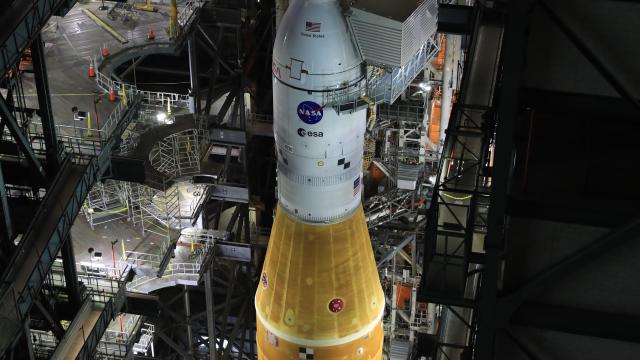NASA is poised to take a major step forward this week as it readies the Space Launch System for its inaugural launch and the official start of the Artemis era.
Speaking to reporters yesterday at a media teleconference, NASA said it has completed its final reviews and — at long last — SLS is finally ready for the launch pad. Charlie Blackwell-Thompson, Artemis launch director at NASA, said “we are in very good shape and ready to proceed with this roll on Thursday evening,” UPI reports. To which he added: “It’s going to be just a wonderful, wonderful sight when we see that amazing Artemis vehicle cross the threshold of the [Vehicle Assembly Building] and we see it outside of that building for the very first time.”
Weighing 5.75 million pounds, the fully stacked rocket — along with the Orion capsule nestled up top — will depart NASA’s Vehicle Assembly Building at 8:00 a.m. AEDT on March 18. The 6.4-kilometre journey will take anywhere from six to 12 hours to complete, as NASA’s Crawler-Transporter 2, moving at less than 2 km per hour, will slowly deliver the rocket to Launch Pad 39B at Kennedy Space Centre in Florida.
The rocket’s arrival at the launch site will set the stage for the critically important wet dress rehearsal, during which time the rocket will be loaded with propellants and a practice countdown conducted and stopped just prior to ignition. The wet dress is currently scheduled for April 3.
According to SpaceNews, NASA expects that it will take over eight hours to load SLS with the liquid hydrogen and liquid oxygen propellants, whereas it took 2.5 hours to load the Space Shuttle, which used similar components. There are two reasons for this, as Blackwell-Thompson explained; first, “it’s a big ol’ stage,” he said during the teleconference, and secondly, SLS has an upper stage that requires fuelling, and the loading process for this rocket must be staggered.
Upon completion of the wet dress rehearsal, the tanks will be drained and the rocket will return to the Vehicle Assembly Building for further tests and tweaks. NASA has yet to announce a date for the first launch of SLS, but during a briefing on February 24, the agency mentioned a launch window that opens on May 7 and closes on May 21. The inaugural launch represents the Artemis 1 mission, the first in the new Artemis lunar program that will eventually see humans land on the Moon again. That Artemis 1 might happen in June or July is not out of the question. NASA will be in a better position to announce the date of the launch upon completion of the wet dress; as Tom Whitmeyer, NASA’s associate administrator for exploration systems development, said during the teleconference, SLS is “a highly complicated vehicle and very complicated machine.”
At launch, the rocket’s quartet of RS-25 engines will provide 8.8 million pounds of thrust, which is 15% more than NASA’s Saturn V rocket from the Apollo era. As a fun aside, SLS will be the tallest rocket on a NASA launch pad since the Apollo 17 mission.
SLS is a much-delayed project, so this is all welcome news. For the Artemis 1 mission, an uncrewed Orion capsule will travel to an orbit 64,374 km beyond the Moon and return to Earth, without reaching the lunar surface. Artemis 2, scheduled for May 2024, will be a repeat, except it will carry a human crew. Artemis 3, which could happen as early as 2025, is the big prize: That’s when two NASA astronauts — a man and a woman — will walk on the Moon.
